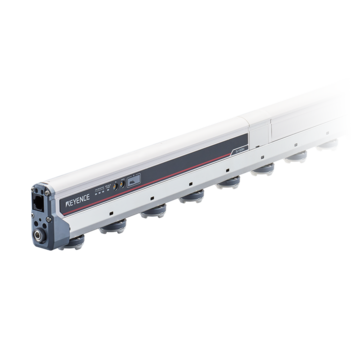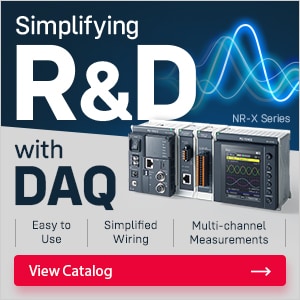Static Control
- Multi-Sensor Ionizer SJ-F700 series
- High-Accuracy High-Speed Sensing Ionizer SJ-Q series
- Energy-Saving High-Speed Sensing Ionizer SJ-E series
- Air-Free High Speed Sensing Ionizer SJ-H series
- Compact Nozzle Static Eliminator SJ-LM series
- Ultra-durable, High-power Static Elimination Gun SJ-LG series
- Compact Fan Static Eliminator SJ-LF series
- High-Performance Micro Static Eliminators SJ-M series
- High-Accuracy Inline Electrostatic Sensor SK series
- Electrostatic Sensor SK-H series
How Ionizers Prevent ESD Damage in Production
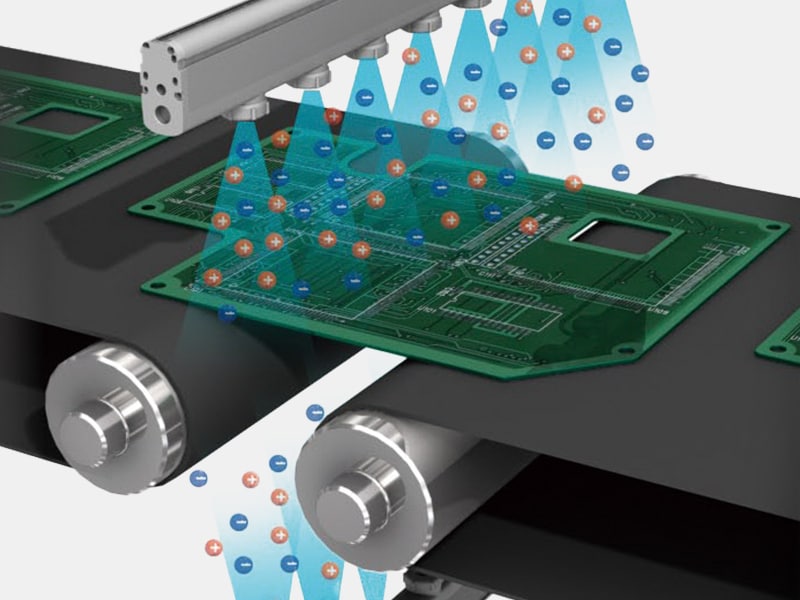
Electrostatic discharge (ESD) doesn’t announce itself with sparks and noise, not in most production environments anyway. It builds silently, clinging to surfaces and transferring through contact before anyone realizes it’s caused damage. In high-precision manufacturing, even minor charges can undermine quality, performance, and reliability, when production speeds increase, static control shifts from a precaution to a necessity. So, how do you prevent ESD damage?
Unfortunately, conventional grounding doesn't solve every ESD problem. Some materials cannot be grounded at all, and certain production layouts limit grounding effectiveness. But in real-world production lines, especially those involving food packaging, complex geometries, or insulative materials, grounding alone doesn’t cut it. Ionizers bridge that gap and neutralize surface charges where grounding can’t reach, protecting components that are otherwise left exposed. This is especially important for facilities handling microelectronics, semiconductors, and other static-sensitive products.
Understanding the Threat of Electrostatic Discharge (ESD) in Manufacturing
Manufacturing environments generate static electricity in countless ways. Friction from material handling, conveyor belts, packaging, and even dry airflow can all produce charge buildup. The result is the invisible but ever-present hazard: ESD. In electronics assembly, the consequences of an unexpected discharge range from immediate component failure to subtle degradation that surfaces only after a device is in the field.
Static charge becomes especially problematic when working with insulative surfaces or isolated conductors that resist traditional grounding. These are common in today’s electronics manufacturing, from polymer housings to epoxy-coated circuit boards. The risk isn't just in how the charge is generated but in how it discharges, often unpredictably and without warning. This is where ESD becomes both a production and reliability threat.
We’re here to provide you with more details.
Reach out today!

Impact on Electronic Components
ESD damage in manufacturing doesn’t need to be visible to be devastating. Many devices are vulnerable at voltages well below human detection. For example, discharges as low as 20 volts can silently compromise a microchip. In some cases, that damage is latent and embedded into the component’s structure only to cause failure weeks or months later. At other times, it manifests immediately as a catastrophic short or a performance drop.
Components most at risk include microprocessors, memory chips, field-programmable gate arrays (FPGAs), and any semiconductor packed with dense circuitry, and as manufacturing tolerances tighten, the electrical sensitivity of these parts increases, leaving little margin for error. Static buildup during transport, testing, or assembly becomes a liability; even the air movement inside a packaging sleeve can produce enough charge to create trouble.
Beyond electrical damage, ESD can also attract dust and contaminants. Charged surfaces behave like magnets for particulates, especially in cleanroom environments, where even microscopic debris can significantly impact yield. For sectors such as medical device manufacturing or aerospace, contamination risks carry the same weight as electrical failures.
Role of Ionizers in ESD Prevention
Where grounding falls short, ionizers work by emitting a controlled balance of positive and negative ions into the environment as an ESD protection method. When those ions encounter a charged object, they bond with the excess electrons (or fill the void where electrons are missing), returning the object to a neutral state.
Ionizers are essential for discharging process-essential insulators, or objects that cannot be grounded because they’re part of the product or tooling. They are also used to stabilize isolated conductors that might accumulate charge during movement or manipulation. In these cases, ionizers surround the workspace with a neutralizing ion field, mitigating risk before a discharge can occur.
In addition to electrostatic discharge control, ionizers also reduce static attraction. Neutral surfaces are less likely to attract airborne contaminants, which improves outcomes in sensitive processes such as lens assembly, printed circuit board (PCB) fabrication, or biomedical packaging.
Discover more about this product.
Click here to book your demo.

Types of Ionizers and Their Applications
Ionizer selection depends on layout, airflow patterns, and how charge is introduced in the process. KEYENCE provides several models to meet specific environmental demands.
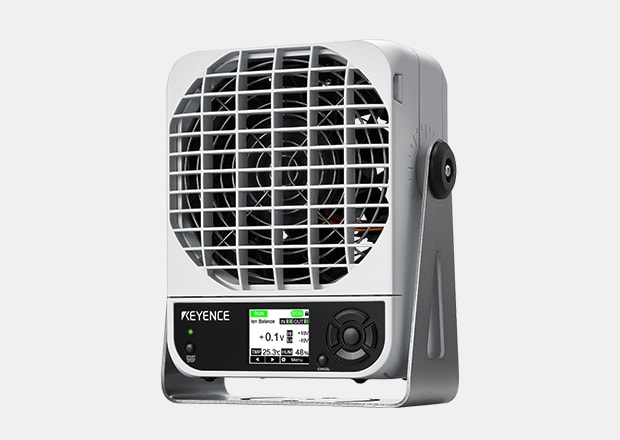
The SJ-F700 Series is a high-output fan-type ionizer designed for broad-area coverage and real-time monitoring. It’s ideal for critical workstations or zones where static builds quickly but grounding isn't possible. Its integrated I/O and ion balance sensors make it a strong choice for automated production lines that need continuous static control without manual calibration.
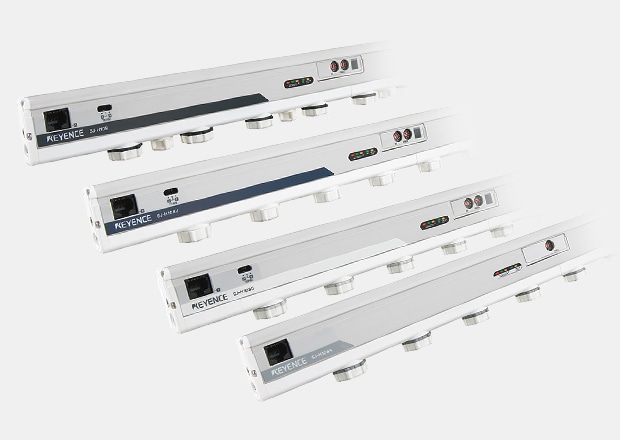
The SJ-H Series is a bar-type ionizer that operates without any airflow assistance, making it well-suited for cleanrooms or airflow-sensitive environments because it doesn’t rely on fans or compressed air. This model is ideal for static control in spaces where maintaining laminar flow or particulate control is needed.
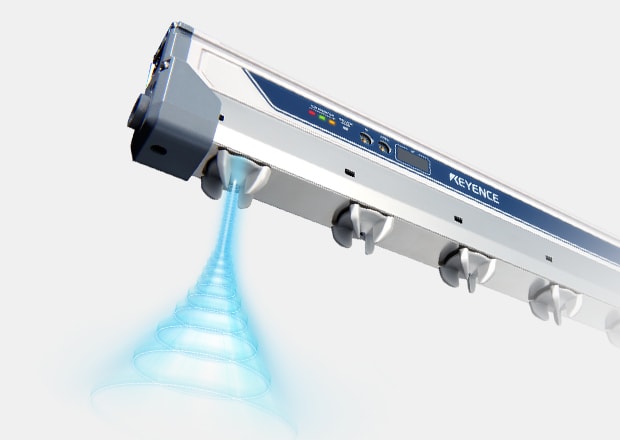
The SJ-E Series offers long-range, wide-area static elimination with high ion output and low airflow disruption. It’s a bar-type ionizer that automatically reduces power when equipment isn’t in use and adjusts ion output based on how close objects are. That makes it a solid fit for high-throughput lines where equipment runs in cycles or sits idle between shifts. It delivers strong static control without using more power than necessary.

The SJ-LG Series, rather than being a compact workspace solution, is a handheld ionizing gun. It excels in targeted applications such as component preparation, packaging, or spot neutralization during manual operations. With trigger-based control and high-precision output, it suits environments where static removal must occur at the operator level or when items are too irregular for fixed discharge.
Get detailed information on our products by downloading our catalog.
View Catalog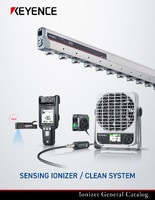

Implementing Ionization in Production Environments
Successful ionization integration begins with identifying insulative hotspots, areas where grounding isn’t feasible, or where components experience regular handling. Once mapped, engineers can select ionizer types based on operational layout, space constraints, and the need for portability or continuous coverage.
Airflow considerations matter. Ionizers reliant on internal fans or facility airflow must be evaluated to ensure adequate ion transport. Poor airflow or obstruction can create uneven neutralization zones, leaving areas of charge intact.
Other ionizers are designed with isolated emitter circuitry, allowing them to operate independently of external grounding and reducing the risk of voltage drift over time. These features help stabilize ion output in high-precision environments while minimizing the need for operator intervention.
While traditional Ionizers require regular maintenance, the benefit of KEYENCE’s SJ-F700 Series, SJ-Q Series, and SJ-E Series is that they are virtually maintenance-free. The SJ-F700 Series has an auto-cleaning function on startup. SJ-Q Series and SJ-E Series have 'Inside Supersonic Structure', which envelops the electrode probe with coaxial air. This airflow prevents debris build-up on probe tips, allowing for probe cleaning reduction to 1x/year and replacement every 10 years- saving time & money.
The Inside Supersonic Structure Envelops the Electrode Probe with Coaxial Air
Standard Ionizer

-
1Standard Ionizer airflow mechanism
-
2Dirt on electrode probe
SJ-Q Series
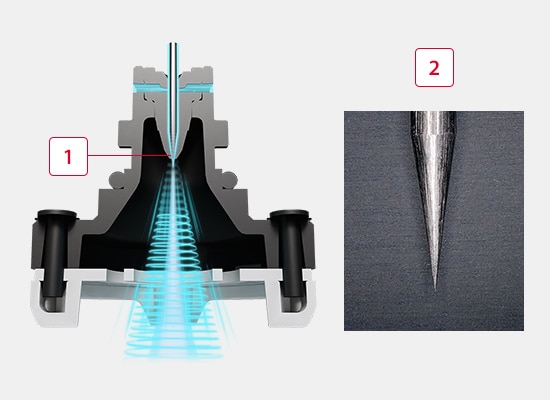
Coaxial air
-
1Inside Supersonic structure
-
2No dirt sticks to electrode probe
Benefits of Effective Electrostatic Discharge Control
A well-implemented ionization strategy serves as a highly effective workplace static control solution. It improves process reliability, reduces contamination, and lowers production losses due to latent ESD damage, and for high-precision industries, such as semiconductors, life sciences, and microelectronics, these gains directly translate to higher yield rates and longer product lifetimes. Reducing ESD also means fewer intermittent issues and failures that are difficult to diagnose post-production, streamlining troubleshooting and preventing costly returns. When ESD damage is minimized at the source, quality assurance efforts become more predictive and less reactive.
Contamination control improves as well. In cleanrooms or controlled environments, particle attraction from static build-up can be a significant source of yield loss. Neutralizing surfaces with ionized air removes this risk, helping maintain clean standards without added filtration.
Finally, reducing the need for costly rework or scrap preserves resources and shortens cycle times. Even small improvements in ESD control can yield large cumulative savings when applied across an entire line or facility.
Eliminating ESD Damage with KEYENCE Ionizers
From cleanroom-ready bar systems to operator-controlled ionizing guns, KEYENCE offers precision tools built for modern manufacturing demands. Eliminate static-related failures before they happen.
Explore our ionizer lineup today.
Contact us to learn more about how our advanced technology can help take your business to the next level.
Contact Us
FAQs
What are the Signs of ESD Damage in Electronic Components?
ESD damage can cause immediate failures like shorts or degraded performance, or latent issues that surface weeks or months later. Components may appear functional at first but fail under normal operating conditions.
How Do Ionizers Neutralize Static Charges?
Ionizers emit balanced positive and negative ions that neutralize surface charges by either discharging excess electrons or filling electron voids.
Can Ionizers Be Used in All Types of Manufacturing Environments?
Yes. Different ionizer types support a wide range of environments, from cleanrooms to high-speed assembly lines.
What Types of Ionizers are Available, and How Do I Choose the Right One for My Production Line?
Common types include fan-type, bar-type (with or without airflow), and handheld ionizing guns. The right choice depends on coverage area, sensitivity to airflow, and whether the static removal is continuous or spot-based.
How Do KEYENCE Ionizers Differ from Traditional Static Elimination Methods?
KEYENCE ionizers actively neutralize charge in places grounding can't reach, including insulative materials and complex geometries. Advanced features like real-time ion balance monitoring and auto-cleaning make them ideal for precision manufacturing.
We’re here to provide you with more details.
Reach out today!


